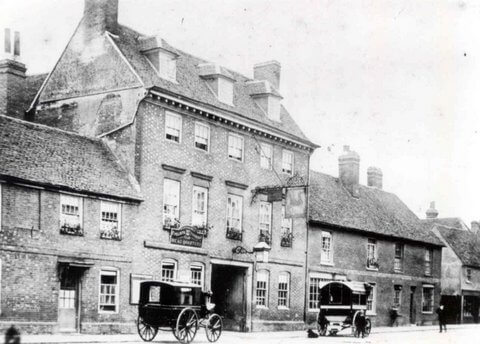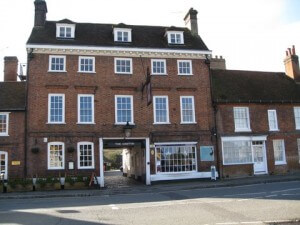(The photos above show the front and back of the Griffin.)
The Griffin Inn (now a restaurant) is a typical old coaching inn with the high arched gateway and cobbled yard. The rear of the Griffin is of the Tudor period, but the front is late 17th century. It used to be called The Wyvern.
Public coaches used the road through Amersham as early as 1662 – the roads were so poor that it was very slow going and probably Amersham being 26 miles from London was an overnight stop for those going to the Midlands. By 1790 with improved roads a coach from Aylesbury to London stopped at the Griffin every morning at 8.00 and the service from London called at the Griffin every afternoon at 2.00. The journey may have taken about 7 hours. The fare from Amersham to London was 7s inside and 3s 6d on top of the coach. By the 1830s with improved coach design and better roads the travelling time reduced dramatically – a coach left Holborn at 8.45 and went via Ealing and Uxbridge arriving at The Griffin by 12 noon. There was also a daily coach from The Crown at 6.00am to the Bull Inn Holborn – 7.00am on Sundays.
During the Civil war in the 17th century, musters of Parliamentary troops passed through Amersham on their way to Aylesbury. Oliver Cromwell is reputed to have dined at the Griffin.
Also the Griffin was known as the ‘Election Pub’. In 1624 Amersham regained the right (after a lapse of 300 years) to return two members of Parliament. Voters met at the Griffin to be “persuaded” by the parliamentary candidates and then after their successful election they returned to entertain the voters and ladies of the town. In 1832 with the Parliamentary Reform Act, the Borough was disenfranchised and declared a Rotten Borough (MPs sponsored by landowner, with very few of the people represented.) Click here to see just how often members of the Drake family were unopposed in the elections.
Another account of the elections is: “The inns of the town were taken possession of at election time by the women-folk, old and young, married and unmarried – the two best inns being selected by the lady inhabitants. Here the fair ones awaited the arrival of the newly elected members who formally entered the room and very deliberately and demurely kissed them in turns. This performance concluded, a raid was made into the inn rooms by the young men of the place, and amid loud laughter and screams and struggles innumerable, they also kissed the not unwilling dames.”
Listen to Jean Archer talking about elections in 1991
Ghost in The Griffin?
A coachman based at the Griffin was chosen to drive the King (possibly George IV). On the anniversary of this the coachman would get extremely drunk on his coach and sit in the yard blowing a coaching horn. When he retired the Inn took the horn away but continued allowing him to get drunk. It is said that on the anniversary of driving the King he can still be heard blowing the horn in the courtyard of the Griffin.
Hotel Visitors Book
Amersham Museum has the visitors’ book for The Griffin Hotel, Broadway, Amersham. The book illustrates Amersham’s long established role as a stopover point for coach travellers just before the town’s fortunes changed with the arrival of the railway in 1892.
The book covers the period 1883 to 1892, but was probably not completed by every guest who stayed at the hotel. The book is only partially full and, sadly, ceased to be used just before the railway arrived at Amersham in September 1892. The last entry, dated 20th January 1892, from Mr F. Bright, is written in shorthand with a translation beside it. The entry is in the form of a ditty declaring The Griffin’s hospitality to be the best in Amersham.
Most entries, however, show Amersham as a stopover between London and towns like Oxford. For instance, Ernest Andrews stayed at The Griffin on route to Malvern via Oxford and probably arrived via coach. In 1884 a guest, who was travelling from London to Bishop’s Stortford, had walked from Rickmansworth to Amersham in the rain!
An interesting comment, in 1890, comes from Thomas Neeler, a Metropolitan Railway inspector, who had ‘called here on 28th September (13 days after Chalfont Road station was burnt down‘. The Morning Bulletin newspaper reported that the fire started when a paraffin lamp was overturned in the porter’s room (paraffin probably provided heat and light to such rooms in this era).
Mr Neeler was also scathing about The Griffin’s hospitality. He notes that he had tea ‘after a terrific struggle with the officers in charge – never again love – cheap certainly but decidedly inferior.’ His comments are swiftly countered on the following page by a visitor who declares the Griffin to offer consistently good service!
Click on any of the photographs below to enlarge it and to see the description. Then click on forward or back arrows at the foot of each photograph. To close the pictures, just click on one.
Notable dates for The Griffin
1642-46 During the Civil War, Oliver Cromwell’s Roundhead Cavalry were quartered in the courtyard. In 1642, Cromwell may well have stopped at the inn when he received a great welcome in Amersham after the Battle of Aylesbury. He certainly called there for refreshment in 1645 on his way to Uxbridge to meet the King’s Commissioners. His wife and family spent part of the Civil War at Woodrow High House, which is near Amersham.
1665 A shameful episode occurred outside the inn during a Quaker funeral procession to the new Quaker Meeting House in Whielden Street of a man named Edward Perrot – who had once travelled to Rome to try to convert the Pope! A barrister named Ambrose Bennett, who had been refreshing himself in the inn, struck one of the coffin bearers with his sword and had the bearers sent to Aylesbury jail. The coffin could not be retrieved for some hours and the corpse was then buried in unconsecrated ground in St. Mary’s churchyard. Those attending the funeral included two well-known local Quakers: Thomas Ellwood, a close friend of John Milton, the poet, and Isaac Penington, who lived at Bury Farm and whose daughter married William Penn, the founder of Pennsylvania.
1723 The landlord was Christopher Redman and he paid an annual rental of £27 and he insured the contenst for £500.
1725 Robert Canby of Slough was the “innholder”, but the landlord seems to have been John Hall, who is mentioned in an advertisement in the Southampton Mercury in September 1726: “On Tuesday the 4th of October next will be run for on Amersham Common, the best of three heats, a four mile course, a plate of ten pound value by any horse mare or gelding, not exceeding fourteen hands, to carry nine stone, all under to be allowed weight for inches to pay one ginea…. N.B. There will be a very good Ordinary each day at Mr John Hall’s at the Griffin in Amersham, and at Mr William Boddison’s at the George Inn in Amersham.”
1737 An advertisement in the London Evening Post in June 1737 described the inn as follows:
To be Lett, and Entered upon immediately, Fit to accommodate Gentlemen, etc.: The Griffin Inn in Amersham, a Market-Town in Bucks, situate in the common high road from London to Aylesbury, being 24 miles distant from London, and nine from Uxbridge in Middlesex, with or without seven acres and a half of Meadow Ground, Part thereof adjoining the Inn.
On the Ground Floor two Kitchens, a Pantry, two Parlours, a Bar and Bar-Room; the second Floor, a Dining-Room, and seven other rooms; on the next Floor, four Rooms, and also other Rooms and Garrets, fitting for Servants; two Cellars, a Wash-house, a Brew-house, a large Yard and Garden, Hostry, two Corn-Lofts, two large Stables and four small ones.
N.B. Two Stage-Coaches from Aylesbury pass through Amersham every Day to and from London.
1739 The rent was £46 p.a. paid by John Culliford
1750 The Inn became a centre for raising the Bucks Militia.
1765 Window tax is paid for 41 windows
1783 William Weller bought the Griffin malthouse
 1791 The Griffin Club, a Friendly Society, was founded and members dined in the inn for many years. It still exists as a charitable organisation, but no longer dines here.
1791 The Griffin Club, a Friendly Society, was founded and members dined in the inn for many years. It still exists as a charitable organisation, but no longer dines here.
1794 It was thought that Berry, the Landlord, was a Sergeant Major in the Bucks Yeomanry, but other records show that William Berry was the landlord in 1872. They may have two people with the same name.
1798 Thomas Jones was the landlord and was described in 1830 as a wine and brandy merchant. By 1839 until at least 1851, Ann Jones was the innkeeper.
1820-30 The inn was an important staging-post for four different coaching services, providing accommodation for drivers and postillions, with stabling for horses.
1847 Disraeli dined at the inn with the farmers attending Amersham market and later held a meeting with electors.
1850s The Griffin became known as the “Election Pub”, where voters met to be bribed by the parliamentary candidate, who then entertained the voters and the ladies of the town after his success. (Amersham ceased to elect two Members of Parliament only after the 1832 Reform Bill.)
1874 Annual dinners were held at the Griffin by the Association for the Protection of Property – an early form of Neighbourhood Watch! One of the photos above shows the Griffin in 1885, before the canopy was built over the archway.
1892 A dinner was held to celebrate the opening of the Metropolitan Railway extension to Amersham.
1900 F. McNeil Whistler, thefamous American artist, lunched at the inn and commented that it was “an old house, charming, and the kitchen amazing”.
20th century – many organisations met at the Griffin. It was the H.Q. for the local Cycling Tourist Cluband for the Ancient Order of Foresters. Wellers Brewery held their annual meetings with a free dinner, free beer and much rowdy fun!
1903 Henry McDonald was the landlord.
1919 The Amersham Bus Company was formed, based at the inn. As the archway was too narrow for the vehicles, they had to enter at the back from Whielden Street. The first petrol pump was installed at the front of the Griffin, selling “Pratt’s Golden”.
1922 During alterations, a Georgian fireplace was discovered, with coins dating back to the seventeenth century.
1928 The Tyrwhitt Drake family sold the building Captain Rice, the tenant. (See photo taken in 1931.)
1997 The Griffin re-opened as an ASK restaurant.












